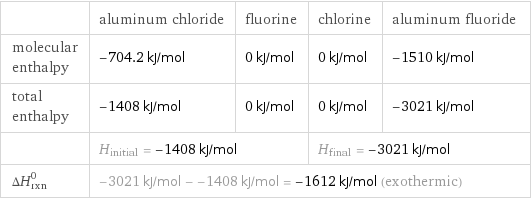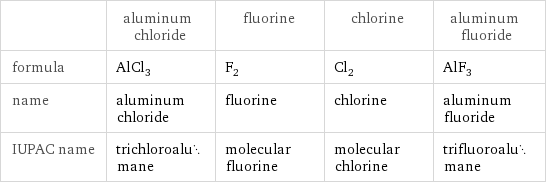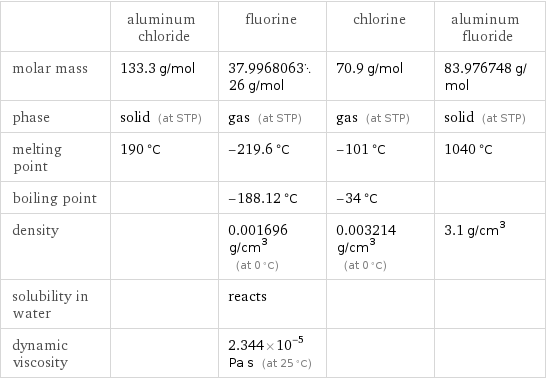Input interpretation

AlCl_3 aluminum chloride + F_2 fluorine ⟶ Cl_2 chlorine + AlF_3 aluminum fluoride
Balanced equation

Balance the chemical equation algebraically: AlCl_3 + F_2 ⟶ Cl_2 + AlF_3 Add stoichiometric coefficients, c_i, to the reactants and products: c_1 AlCl_3 + c_2 F_2 ⟶ c_3 Cl_2 + c_4 AlF_3 Set the number of atoms in the reactants equal to the number of atoms in the products for Al, Cl and F: Al: | c_1 = c_4 Cl: | 3 c_1 = 2 c_3 F: | 2 c_2 = 3 c_4 Since the coefficients are relative quantities and underdetermined, choose a coefficient to set arbitrarily. To keep the coefficients small, the arbitrary value is ordinarily one. For instance, set c_1 = 1 and solve the system of equations for the remaining coefficients: c_1 = 1 c_2 = 3/2 c_3 = 3/2 c_4 = 1 Multiply by the least common denominator, 2, to eliminate fractional coefficients: c_1 = 2 c_2 = 3 c_3 = 3 c_4 = 2 Substitute the coefficients into the chemical reaction to obtain the balanced equation: Answer: | | 2 AlCl_3 + 3 F_2 ⟶ 3 Cl_2 + 2 AlF_3
Structures

+ ⟶ +
Names

aluminum chloride + fluorine ⟶ chlorine + aluminum fluoride
Reaction thermodynamics
Enthalpy

| aluminum chloride | fluorine | chlorine | aluminum fluoride molecular enthalpy | -704.2 kJ/mol | 0 kJ/mol | 0 kJ/mol | -1510 kJ/mol total enthalpy | -1408 kJ/mol | 0 kJ/mol | 0 kJ/mol | -3021 kJ/mol | H_initial = -1408 kJ/mol | | H_final = -3021 kJ/mol | ΔH_rxn^0 | -3021 kJ/mol - -1408 kJ/mol = -1612 kJ/mol (exothermic) | | |
Gibbs free energy

| aluminum chloride | fluorine | chlorine | aluminum fluoride molecular free energy | -628.8 kJ/mol | 0 kJ/mol | 0 kJ/mol | -1431 kJ/mol total free energy | -1258 kJ/mol | 0 kJ/mol | 0 kJ/mol | -2862 kJ/mol | G_initial = -1258 kJ/mol | | G_final = -2862 kJ/mol | ΔG_rxn^0 | -2862 kJ/mol - -1258 kJ/mol = -1605 kJ/mol (exergonic) | | |
Equilibrium constant
![Construct the equilibrium constant, K, expression for: AlCl_3 + F_2 ⟶ Cl_2 + AlF_3 Plan: • Balance the chemical equation. • Determine the stoichiometric numbers. • Assemble the activity expression for each chemical species. • Use the activity expressions to build the equilibrium constant expression. Write the balanced chemical equation: 2 AlCl_3 + 3 F_2 ⟶ 3 Cl_2 + 2 AlF_3 Assign stoichiometric numbers, ν_i, using the stoichiometric coefficients, c_i, from the balanced chemical equation in the following manner: ν_i = -c_i for reactants and ν_i = c_i for products: chemical species | c_i | ν_i AlCl_3 | 2 | -2 F_2 | 3 | -3 Cl_2 | 3 | 3 AlF_3 | 2 | 2 Assemble the activity expressions accounting for the state of matter and ν_i: chemical species | c_i | ν_i | activity expression AlCl_3 | 2 | -2 | ([AlCl3])^(-2) F_2 | 3 | -3 | ([F2])^(-3) Cl_2 | 3 | 3 | ([Cl2])^3 AlF_3 | 2 | 2 | ([AlF3])^2 The equilibrium constant symbol in the concentration basis is: K_c Mulitply the activity expressions to arrive at the K_c expression: Answer: | | K_c = ([AlCl3])^(-2) ([F2])^(-3) ([Cl2])^3 ([AlF3])^2 = (([Cl2])^3 ([AlF3])^2)/(([AlCl3])^2 ([F2])^3)](../image_source/ff271fef61a2ed78d71f61ba4c2b1315.png)
Construct the equilibrium constant, K, expression for: AlCl_3 + F_2 ⟶ Cl_2 + AlF_3 Plan: • Balance the chemical equation. • Determine the stoichiometric numbers. • Assemble the activity expression for each chemical species. • Use the activity expressions to build the equilibrium constant expression. Write the balanced chemical equation: 2 AlCl_3 + 3 F_2 ⟶ 3 Cl_2 + 2 AlF_3 Assign stoichiometric numbers, ν_i, using the stoichiometric coefficients, c_i, from the balanced chemical equation in the following manner: ν_i = -c_i for reactants and ν_i = c_i for products: chemical species | c_i | ν_i AlCl_3 | 2 | -2 F_2 | 3 | -3 Cl_2 | 3 | 3 AlF_3 | 2 | 2 Assemble the activity expressions accounting for the state of matter and ν_i: chemical species | c_i | ν_i | activity expression AlCl_3 | 2 | -2 | ([AlCl3])^(-2) F_2 | 3 | -3 | ([F2])^(-3) Cl_2 | 3 | 3 | ([Cl2])^3 AlF_3 | 2 | 2 | ([AlF3])^2 The equilibrium constant symbol in the concentration basis is: K_c Mulitply the activity expressions to arrive at the K_c expression: Answer: | | K_c = ([AlCl3])^(-2) ([F2])^(-3) ([Cl2])^3 ([AlF3])^2 = (([Cl2])^3 ([AlF3])^2)/(([AlCl3])^2 ([F2])^3)
Rate of reaction
![Construct the rate of reaction expression for: AlCl_3 + F_2 ⟶ Cl_2 + AlF_3 Plan: • Balance the chemical equation. • Determine the stoichiometric numbers. • Assemble the rate term for each chemical species. • Write the rate of reaction expression. Write the balanced chemical equation: 2 AlCl_3 + 3 F_2 ⟶ 3 Cl_2 + 2 AlF_3 Assign stoichiometric numbers, ν_i, using the stoichiometric coefficients, c_i, from the balanced chemical equation in the following manner: ν_i = -c_i for reactants and ν_i = c_i for products: chemical species | c_i | ν_i AlCl_3 | 2 | -2 F_2 | 3 | -3 Cl_2 | 3 | 3 AlF_3 | 2 | 2 The rate term for each chemical species, B_i, is 1/ν_i(Δ[B_i])/(Δt) where [B_i] is the amount concentration and t is time: chemical species | c_i | ν_i | rate term AlCl_3 | 2 | -2 | -1/2 (Δ[AlCl3])/(Δt) F_2 | 3 | -3 | -1/3 (Δ[F2])/(Δt) Cl_2 | 3 | 3 | 1/3 (Δ[Cl2])/(Δt) AlF_3 | 2 | 2 | 1/2 (Δ[AlF3])/(Δt) (for infinitesimal rate of change, replace Δ with d) Set the rate terms equal to each other to arrive at the rate expression: Answer: | | rate = -1/2 (Δ[AlCl3])/(Δt) = -1/3 (Δ[F2])/(Δt) = 1/3 (Δ[Cl2])/(Δt) = 1/2 (Δ[AlF3])/(Δt) (assuming constant volume and no accumulation of intermediates or side products)](../image_source/6d7e57b6c946dc4286ae81b01f4a6b83.png)
Construct the rate of reaction expression for: AlCl_3 + F_2 ⟶ Cl_2 + AlF_3 Plan: • Balance the chemical equation. • Determine the stoichiometric numbers. • Assemble the rate term for each chemical species. • Write the rate of reaction expression. Write the balanced chemical equation: 2 AlCl_3 + 3 F_2 ⟶ 3 Cl_2 + 2 AlF_3 Assign stoichiometric numbers, ν_i, using the stoichiometric coefficients, c_i, from the balanced chemical equation in the following manner: ν_i = -c_i for reactants and ν_i = c_i for products: chemical species | c_i | ν_i AlCl_3 | 2 | -2 F_2 | 3 | -3 Cl_2 | 3 | 3 AlF_3 | 2 | 2 The rate term for each chemical species, B_i, is 1/ν_i(Δ[B_i])/(Δt) where [B_i] is the amount concentration and t is time: chemical species | c_i | ν_i | rate term AlCl_3 | 2 | -2 | -1/2 (Δ[AlCl3])/(Δt) F_2 | 3 | -3 | -1/3 (Δ[F2])/(Δt) Cl_2 | 3 | 3 | 1/3 (Δ[Cl2])/(Δt) AlF_3 | 2 | 2 | 1/2 (Δ[AlF3])/(Δt) (for infinitesimal rate of change, replace Δ with d) Set the rate terms equal to each other to arrive at the rate expression: Answer: | | rate = -1/2 (Δ[AlCl3])/(Δt) = -1/3 (Δ[F2])/(Δt) = 1/3 (Δ[Cl2])/(Δt) = 1/2 (Δ[AlF3])/(Δt) (assuming constant volume and no accumulation of intermediates or side products)
Chemical names and formulas

| aluminum chloride | fluorine | chlorine | aluminum fluoride formula | AlCl_3 | F_2 | Cl_2 | AlF_3 name | aluminum chloride | fluorine | chlorine | aluminum fluoride IUPAC name | trichloroalumane | molecular fluorine | molecular chlorine | trifluoroalumane
Substance properties

| aluminum chloride | fluorine | chlorine | aluminum fluoride molar mass | 133.3 g/mol | 37.996806326 g/mol | 70.9 g/mol | 83.976748 g/mol phase | solid (at STP) | gas (at STP) | gas (at STP) | solid (at STP) melting point | 190 °C | -219.6 °C | -101 °C | 1040 °C boiling point | | -188.12 °C | -34 °C | density | | 0.001696 g/cm^3 (at 0 °C) | 0.003214 g/cm^3 (at 0 °C) | 3.1 g/cm^3 solubility in water | | reacts | | dynamic viscosity | | 2.344×10^-5 Pa s (at 25 °C) | |
Units
